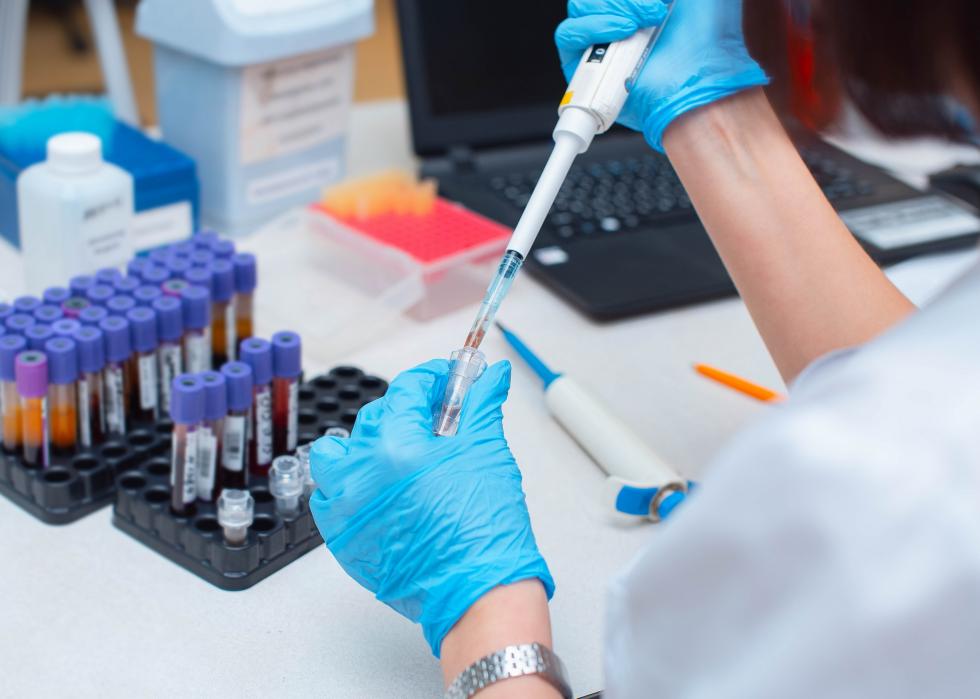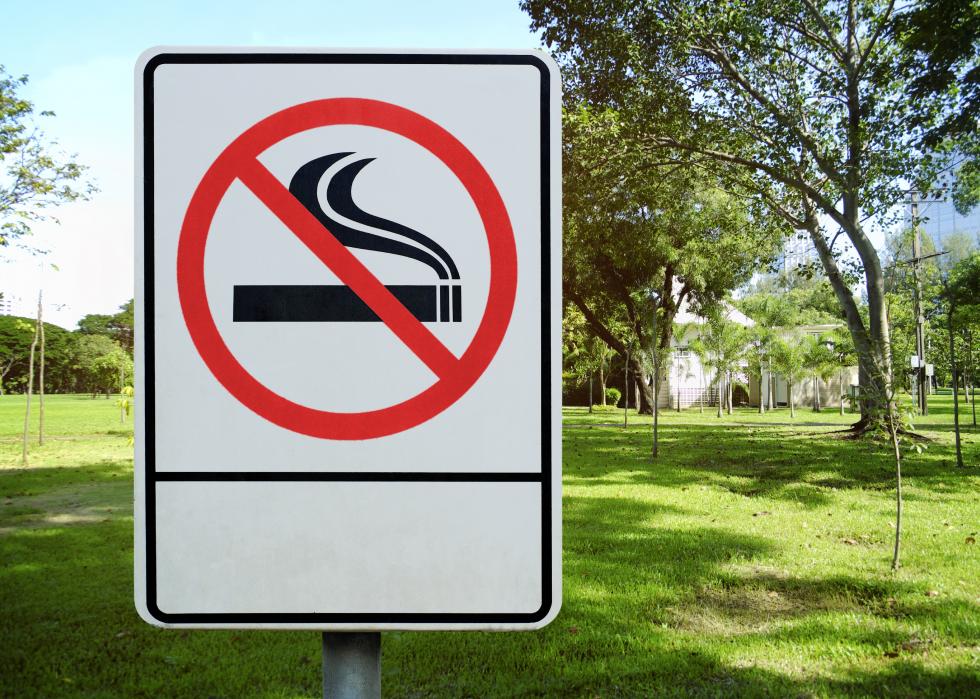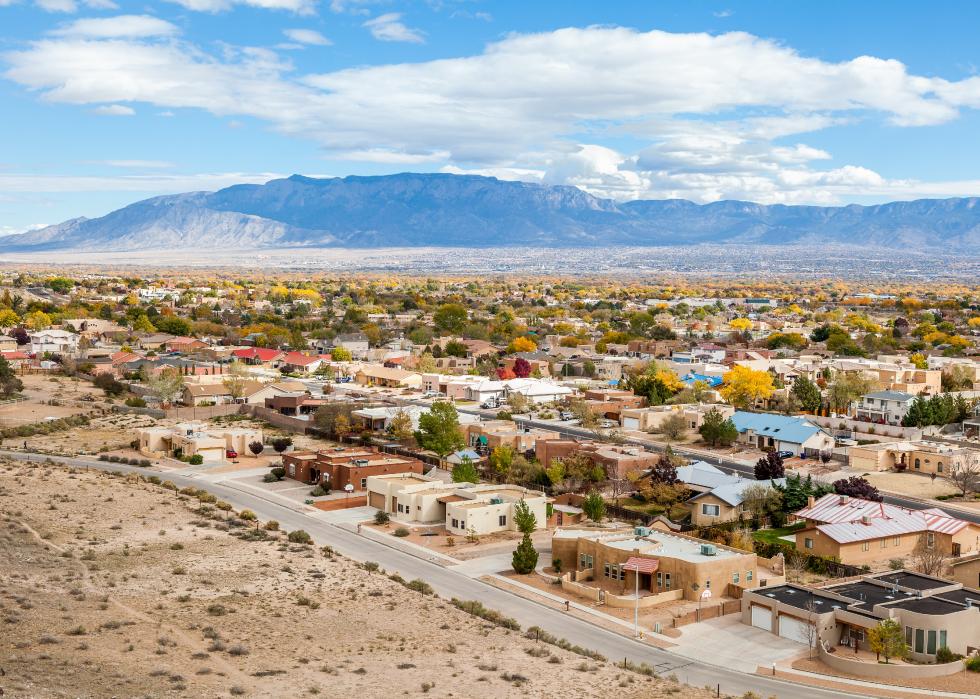
How much every state spends on public health
How much every state spends on public health
Public health is the branch of medicine that deals with prolonging and improving the quality of life across entire populations. Such a task is wide-reaching and can include anything from public education campaigns and hygiene mandates to disease-prevention initiatives and anti-addiction or non-smoking initiatives.
In the United States, individual states are responsible for creating, administering, funding, and overseeing public health policies, services, initiatives, and governing bodies—but not all states put an equal amount of resources into the cause.
To examine how much every state spends on public health, Stacker consulted a Kaiser Health News and Associated Press analysis conducted in summer 2020, in conjunction with the Kaiser Health News "Underfunded And Under Threat" series. State- and county-level spending data are from the U.S. Census Bureau Annual Survey of State and Local Government Finances and the State Health Expenditure Dataset and are up to date as of 2017. State public health agency spending data are from the Association of State and Territorial Health Officials and are up to date as of 2018. Ranks included in the story are based on per capita spending figures. All figures in the story are adjusted to 2019 dollars.
The COVID-19 crisis forced many states to reexamine their public health budgets or even the framework of their entire public health infrastructure. In other states, years of cuts to public health budgets came home to roost when the pandemic revealed gaping inadequacies in equipment, staff, facilities, and strategic plans of action.
Keep reading to learn which states spend the most on public health, in order from the lowest spenders to the biggest, plus what they're doing right, what they're doing wrong, the challenges they're facing, and the opportunities they're seizing.
You may also like: Most and least healthy states in America

#51. Arizona
- Total state public health spending (2017): $532.1 million ($76 per capita)
--- Hospital spending (2017): $5.0 million ($1 per capita, #1 lowest among all states)
--- Non-hospital spending (2017): $527.1 million ($75 per capita, #6 lowest)
--- Public health agency spending (2018): $576.3 million ($79 per capita, 16.4% up from 2010)
- Counties spending the most on public health (2017):
--- #1. Navajo County ($156.7 million total, $1,437 per capita)
--- #2. Greenlee County ($2.1 million total, $226 per capita)
--- #3. Maricopa County ($757.0 million total, $175 per capita)
Some experts in 2020 argued that the state's paltry per capita health care spending actually represents a commitment to building for the future. Some of that funding goes to investments in future infrastructure, disease-protection efforts, and the mitigation of health disparities.

#50. Indiana
- Total state public health spending (2017): $731.0 million ($110 per capita)
--- Hospital spending (2017): $149.1 million ($22 per capita, #3 lowest among all states)
--- Non-hospital spending (2017): $581.8 million ($87 per capita, #10 lowest)
--- Public health agency spending (2018): $405.6 million ($59 per capita, 5.7% down from 2010)
- Counties spending the most on public health (2017):
--- #1. Knox County ($225.4 million total, $6,084 per capita)
--- #2. Bartholomew County ($397.8 million total, $4,839 per capita)
--- #3. Dubois County ($200.4 million total, $4,711 per capita)
The 2020 public health funding report from the United Health Foundations (UHF) found Indiana benefits from low instances of excessive drinking among its population but suffers from a high prevalence of smoking. There are only small differences in health disparity by high school education, but immunization rates among children are low, and there aren't enough mental health providers in the state.

#49. Idaho
- Total state public health spending (2017): $210.2 million ($122 per capita)
--- Hospital spending (2017): $55.4 million ($32 per capita, #5 lowest among all states)
--- Non-hospital spending (2017): $154.8 million ($90 per capita, #11 lowest)
--- Public health agency spending (2018): $102.0 million ($57 per capita, 3.0% down from 2010)
- Counties spending the most on public health (2017):
--- #1. Kootenai County ($468.3 million total, $2,977 per capita)
--- #2. Butte County ($6.5 million total, $2,509 per capita)
--- #3. Benewah County ($21.9 million total, $2,390 per capita)
The Get Healthy Idaho program represents a "major shift in the way Idaho funds and addresses population-level prevention and health promotion strategies," according to the program's website. The initiative has been working on a five-year plan to identify and address the state's most pressing health priorities.

#48. New Hampshire
- Total state public health spending (2017): $168.8 million ($125 per capita)
--- Hospital spending (2017): $65.2 million ($48 per capita, #8 lowest among all states)
--- Non-hospital spending (2017): $103.6 million ($77 per capita, #7 lowest)
--- Public health agency spending (2018): $86.6 million ($63 per capita, 18.6% down from 2010)
- Counties spending the most on public health (2017):
--- #1. Carroll County ($1.9 million total, $40 per capita)
--- #2. Coos County ($1.1 million total, $35 per capita)
--- #3. Sullivan County ($1.4 million total, $33 per capita)
Legislation enacted in 2007 created the Public Health Improvement Services Council, an organization tasked with overseeing New Hampshire's public health improvement initiatives. The council, among other things, conducts regular workshops designed to address the state's six-point public health action plan.

#47. Minnesota
- Total state public health spending (2017): $762.8 million ($137 per capita)
--- Hospital spending (2017): $332.6 million ($60 per capita, #10 lowest among all states)
--- Non-hospital spending (2017): $430.2 million ($77 per capita, #8 lowest)
--- Public health agency spending (2018): $585.9 million ($102 per capita, 3.8% down from 2010)
- Counties spending the most on public health (2017):
--- #1. Big Stone County ($31.3 million total, $6,245 per capita)
--- #2. Cook County ($28.1 million total, $5,200 per capita)
--- #3. Kandiyohi County ($125.3 million total, $2,930 per capita)
Minnesota has put an emphasis on remote health care, which has proven to be an indispensable resource during the pandemic. The Minnesota e-Health Initiative represents a collaboration between the government and the private sector. It's overseen by a 25-member council that was created through legislation.

#46. Tennessee
- Total state public health spending (2017): $1.0 billion ($151 per capita)
--- Hospital spending (2017): $351.3 million ($52 per capita, #9 lowest among all states)
--- Non-hospital spending (2017): $658.7 million ($98 per capita, #16 lowest)
--- Public health agency spending (2018): $545.1 million ($79 per capita, 11.7% down from 2010)
- Counties spending the most on public health (2017):
--- #1. Madison County ($676.0 million total, $6,934 per capita)
--- #2. Maury County ($347.7 million total, $3,770 per capita)
--- #3. Putnam County ($285.1 million total, $3,688 per capita)
The Tennessee Health Care Innovation Initiative is based on three strategies: primary care, episodes of care like surgery or inpatient hospitalization, and long-term services and supports.

#45. Illinois
- Total state public health spending (2017): $2.1 billion ($167 per capita)
--- Hospital spending (2017): $967.0 million ($76 per capita, #15 lowest among all states)
--- Non-hospital spending (2017): $1.2 billion ($91 per capita, #13 lowest)
--- Public health agency spending (2018): $391.6 million ($30 per capita, 12.8% down from 2010)
- Counties spending the most on public health (2017):
--- #1. Whiteside County ($228.9 million total, $4,091 per capita)
--- #2. Schuyler County ($23.9 million total, $3,440 per capita)
--- #3. Wabash County ($36.5 million total, $3,167 per capita)
There are plenty of dentists in Illinois, and child immunization rates are strong, but residents there suffer from excess pollution, and they're considered statistically more likely to be problem drinkers. The largest health care crisis, however, is drug addiction. Drug deaths in Illinois increased by 63% in the last five years alone.

#44. Louisiana
- Total state public health spending (2017): $824.9 million ($177 per capita)
--- Hospital spending (2017): $378.0 million ($81 per capita, #18 lowest among all states)
--- Non-hospital spending (2017): $446.9 million ($96 per capita, #14 lowest)
--- Public health agency spending (2018): $330.4 million ($69 per capita, 16.5% down from 2010)
- Counties spending the most on public health (2017):
--- #1. St. James Parish ($55.4 million total, $2,590 per capita)
--- #2. Terrebonne Parish ($279.0 million total, $2,495 per capita)
--- #3. Tangipahoa Parish ($321.6 million total, $2,430 per capita)
Louisiana has the benefit of a unique 501(c)(3) called the Louisiana Public Health Institute, which works toward improvements in population-level health. Created through a Concurrent Resolution in 1997, its seven key focus areas include tobacco prevention and control, behavioral health, family health, and HIV/STI.

#43. Nevada
- Total state public health spending (2017): $570.8 million ($192 per capita)
--- Hospital spending (2017): $285.5 million ($96 per capita, #22 lowest among all states)
--- Non-hospital spending (2017): $285.4 million ($96 per capita, #15 lowest)
--- Public health agency spending (2018): $198.3 million ($64 per capita, 25.1% down from 2010)
- Counties spending the most on public health (2017):
--- #1. Humboldt County ($55.5 million total, $3,321 per capita)
--- #2. White Pine County ($30.2 million total, $3,127 per capita)
--- #3. Lander County ($17.1 million total, $3,058 per capita)
Launched in 2018, Nevada's Public Health 3.0 program is an ambitious overhaul of many state services and policies. It places a heavy focus on social health determinants like neighborhoods, schools, employment, income, and diet.

#42. South Dakota
- Total state public health spending (2017): $189.0 million ($217 per capita)
--- Hospital spending (2017): $25.0 million ($29 per capita, #4 lowest among all states)
--- Non-hospital spending (2017): $164.0 million ($188 per capita, #21 highest)
--- Public health agency spending (2018): $108.5 million ($121 per capita, 1.1% down from 2010)
- Counties spending the most on public health (2017):
--- #1. Faulk County ($11.0 million total, $4,748 per capita)
--- #2. Brookings County ($83.4 million total, $2,399 per capita)
--- #3. Spink County ($10.4 million total, $1,598 per capita)
The South Dakota Department of Health in 2020 unveiled a five-year plan for public health. The plan aims to increase accessibility, improve the health care workforce, forge new private partnerships, plan and prepare for public health emergencies, and improve service-oriented public health.

#41. West Virginia
- Total state public health spending (2017): $408.8 million ($225 per capita)
--- Hospital spending (2017): $159.3 million ($88 per capita, #19 lowest among all states)
--- Non-hospital spending (2017): $249.5 million ($137 per capita, #25 lowest)
--- Public health agency spending (2018): $183.9 million ($100 per capita, 27.3% down from 2010)
- Counties spending the most on public health (2017):
--- #1. Grant County ($36.8 million total, $3,169 per capita)
--- #2. Tyler County ($23.3 million total, $2,643 per capita)
--- #3. Webster County ($18.2 million total, $2,180 per capita)
The COVID-19 crisis put the consequences of West Virginia's years-long public health budget cuts on display. Between 2010 and 2018, public health spending declined by 27%, leaving as many as 1 in 4 health department jobs vacant. In the critical sphere of epidemiology, it was closer to 1 in 3.

#40. Maine
- Total state public health spending (2017): $319.5 million ($239 per capita)
--- Hospital spending (2017): $105.6 million ($79 per capita, #17 lowest among all states)
--- Non-hospital spending (2017): $213.8 million ($160 per capita, #24 highest)
--- Public health agency spending (2018): $105.8 million ($77 per capita, 19.4% down from 2010)
- Counties spending the most on public health (2017):
--- #1. Piscataquis County ($50.5 million total, $3,007 per capita)
--- #2. Aroostook County ($65.8 million total, $974 per capita)
--- #3. Washington County ($3.3 million total, $106 per capita)
Maine is grappling with residents with multiple chronic conditions and a low prevalence of exercise, according to the UHF report. On the positive side, many children are immunized and there's a low rate of non-medical drug use.

#39. Georgia
- Total state public health spending (2017): $2.6 billion ($246 per capita)
--- Hospital spending (2017): $1.2 billion ($118 per capita, #25 lowest among all states)
--- Non-hospital spending (2017): $1.3 billion ($127 per capita, #24 lowest)
--- Public health agency spending (2018): $757.3 million ($71 per capita, 1.1% up from 2010)
- Counties spending the most on public health (2017):
--- #1. Tift County ($300.1 million total, $7,422 per capita)
--- #2. Miller County ($42.4 million total, $7,297 per capita)
--- #3. Toombs County ($156.2 million total, $5,816 per capita)
In the fiscal year 2021, Georgia is budgeted to spend about $4 billion on programs related to health care. About half of that, $2 billion, will flow to about 2 million Georgians through Medicaid. Only 6% of the state's budget is allocated for public health.

#38. Alaska
- Total state public health spending (2017): $185.8 million ($251 per capita)
--- Hospital spending (2017): $30.6 million ($41 per capita, #7 lowest among all states)
--- Non-hospital spending (2017): $155.1 million ($210 per capita, #15 highest)
--- Public health agency spending (2018): $106.4 million ($142 per capita, 2.3% up from 2010)
- Counties spending the most on public health (2017):
--- #1. Wrangell City and Borough ($11.6 million total, $4,599 per capita)
--- #2. Sitka City and Borough ($35.7 million total, $4,135 per capita)
--- #3. Kenai Peninsula Borough ($241.2 million total, $4,120 per capita)
Violent crime and diabetes are on the rise in Alaska, according to the UHF report, both of which directly impact the state's public health system. Smoking is way down in the state, with the percentage of adult smokers now down to less than 20%. Overall, a high rate of uninsured citizens aggravates all public health challenges.

#37. Nebraska
- Total state public health spending (2017): $483.5 million ($252 per capita)
--- Hospital spending (2017): $201.7 million ($105 per capita, #23 lowest among all states)
--- Non-hospital spending (2017): $281.9 million ($147 per capita, #26 highest)
--- Public health agency spending (2018): $167.3 million ($85 per capita, 13.8% down from 2010)
- Counties spending the most on public health (2017):
--- #1. Perkins County ($22.6 million total, $7,823 per capita)
--- #2. Boone County ($32.1 million total, $6,041 per capita)
--- #3. Garden County ($10.4 million total, $5,515 per capita)
Obesity is a public health challenge in Nebraska, as is excessive drinking, according to the UHF report—although the former is on the rise and the latter is getting better. Also, instances of low birth weight have increased by more than 40% since 1992.

#36. Florida
- Total state public health spending (2017): $5.5 billion ($261 per capita)
--- Hospital spending (2017): $1.3 billion ($61 per capita, #11 lowest among all states)
--- Non-hospital spending (2017): $4.2 billion ($200 per capita, #18 highest)
--- Public health agency spending (2018): $2.6 billion ($120 per capita, 2.3% down from 2010)
- Counties spending the most on public health (2017):
--- #1. Lee County ($1.7 billion total, $2,248 per capita)
--- #2. Sarasota County ($761.2 million total, $1,814 per capita)
--- #3. Broward County ($3.3 billion total, $1,724 per capita)
Health care spending declined by 41% in Florida between 2010 and 2020, even though the population grew by 2.4 million. And the state struggled during the COVID-19 crisis: Gov. Ron DeSantis was inconsistent with messaging while well-documented reports chronicled a systematic campaign of muzzling public health experts, concealing or misrepresenting key data to the public, and making policy decisions based on partisan politics.

#35. Colorado
- Total state public health spending (2017): $1.5 billion ($268 per capita)
--- Hospital spending (2017): $1.1 billion ($196 per capita, #26 highest among all states)
--- Non-hospital spending (2017): $404.2 million ($72 per capita, #5 lowest)
--- Public health agency spending (2018): $571.8 million ($98 per capita, 10.4% up from 2010)
- Counties spending the most on public health (2017):
--- #1. Pitkin County ($126.2 million total, $7,024 per capita)
--- #2. Phillips County ($24.3 million total, $5,661 per capita)
--- #3. Rio Blanco County ($33.8 million total, $5,323 per capita)
A contentious and controversial bill—which put Colorado at the center of the national debate on funding health care—was introduced in 2020. The bill, which would have created a hybrid public insurance option for the 8% of state residents who purchase insurance on the individual market, has been abandoned, but backers plan to revisit their efforts. no

#34. Montana
- Total state public health spending (2017): $286.0 million ($272 per capita)
--- Hospital spending (2017): $69.2 million ($66 per capita, #13 lowest among all states)
--- Non-hospital spending (2017): $216.8 million ($206 per capita, #16 highest)
--- Public health agency spending (2018): $70.8 million ($65 per capita, 15.5% down from 2010)
- Counties spending the most on public health (2017):
--- #1. Toole County ($19.3 million total, $3,965 per capita)
--- #2. Beaverhead County ($30.6 million total, $3,239 per capita)
--- #3. Pondera County ($15.5 million total, $2,596 per capita)
Excessive drinking is a challenge to public health in Montana, according to the UHF report, as are low childhood immunization rates and a shortage of primary care physicians. On the bright side, the obesity and diabetes epidemics that plague so much of the country are not as significant in Montana compared to the larger population.

#33. North Dakota
- Total state public health spending (2017): $206.3 million ($273 per capita)
--- Hospital spending (2017): $56.9 million ($75 per capita, #14 lowest among all states)
--- Non-hospital spending (2017): $149.4 million ($198 per capita, #19 highest)
--- Public health agency spending (2018): $88.2 million ($114 per capita, 7.2% down from 2010)
- Counties spending the most on public health (2017):
--- #1. Kidder County ($4.7 million total, $1,903 per capita)
--- #2. Golden Valley County ($1.6 million total, $915 per capita)
--- #3. Billings County ($711,000 total, $771 per capita)
The North Dakota Emergency Commission in March 2020 voted unanimously to accept $6 million from the federal government to fight the COVID-19 pandemic. More than half the money went to bolstering PPE and other sorely-needed medical supplies.

#32. Rhode Island
- Total state public health spending (2017): $293.7 million ($278 per capita)
--- Hospital spending (2017): $65.3 million ($62 per capita, #12 lowest among all states)
--- Non-hospital spending (2017): $228.5 million ($216 per capita, #13 highest)
--- Public health agency spending (2018): $163.0 million ($151 per capita, 1.8% up from 2010)
- Counties spending the most on public health (2017):
--- #1. Newport County ($11.0 million total, $132 per capita)
--- #2. Washington County ($4.0 million total, $32 per capita)
--- #3. Bristol County ($917,000 total, $19 per capita)
The leadership of Rhode Island, including the Governor's Office, partnered with Brown University's School of Public Health to conduct an analysis of patterns regarding public health care spending in the state. Called the Rhode Island Health Care Cost Trends Project, the initiative involves several top state agencies and is funded with a $550,000 grant from the Peterson Center on Healthcare.

#31. Maryland
- Total state public health spending (2017): $1.7 billion ($280 per capita)
--- Hospital spending (2017): $570.6 million ($95 per capita, #21 lowest among all states)
--- Non-hospital spending (2017): $1.1 billion ($186 per capita, #22 highest)
--- Public health agency spending (2018): $452.6 million ($73 per capita, 13.0% down from 2010)
- Counties spending the most on public health (2017):
--- #1. Garrett County ($53.5 million total, $1,829 per capita)
--- #2. Baltimore city ($116.6 million total, $191 per capita)
--- #3. Frederick County ($34.7 million total, $138 per capita)
No state in America has a health care system quite like Maryland's, where a so-called "global hospital budget" holds promise as a model with incredible potential in the modern age. It has two distinctive characteristics. First, the all-payer rate setting has regulated the price that hospitals can charge for medical care since the 1970s, and second, it caps health care spending growth—including how much revenue hospitals are allowed to take in.

#30. Oklahoma
- Total state public health spending (2017): $1.1 billion ($290 per capita)
--- Hospital spending (2017): $304.4 million ($77 per capita, #16 lowest among all states)
--- Non-hospital spending (2017): $833.7 million ($212 per capita, #14 highest)
--- Public health agency spending (2018): $332.6 million ($83 per capita, 22.7% down from 2010)
- Counties spending the most on public health (2017):
--- #1. Jackson County ($71.9 million total, $2,864 per capita)
--- #2. Comanche County ($256.3 million total, $2,104 per capita)
--- #3. Cherokee County ($97.1 million total, $1,985 per capita)
Oklahoma slashed health care spending in 2014 in an effort to cope with gaping budget shortfalls that arose as a result of falling oil prices and irresponsible tax cuts and corporate giveaways. When the situation improved, the money was never directed back to fill the shortfall, and the state was woefully unprepared when the pandemic found its way to Oklahoma.

#29. North Carolina
- Total state public health spending (2017): $3.3 billion ($320 per capita)
--- Hospital spending (2017): $2.3 billion ($220 per capita, #25 highest among all states)
--- Non-hospital spending (2017): $1.0 billion ($100 per capita, #17 lowest)
--- Public health agency spending (2018): $755.9 million ($71 per capita, 21.3% down from 2010)
- Counties spending the most on public health (2017):
--- #1. Duplin County ($318.7 million total, $5,408 per capita)
--- #2. Mecklenburg County ($5.5 billion total, $5,144 per capita)
--- #3. New Hanover County ($1.1 billion total, $4,828 per capita)
Officials in North Carolina apparently spent the state's share of CARES Act funding wisely. In a report outlining exactly how many federal dollars were allocated to which state health agencies, the Governor's Office pointed out that the state missed both the initial wave in the Northeast and the surge that plagued many of its Southern neighbors in summer 2020.

#28. Massachusetts
- Total state public health spending (2017): $2.3 billion ($329 per capita)
--- Hospital spending (2017): $759.2 million ($111 per capita, #24 lowest among all states)
--- Non-hospital spending (2017): $1.5 billion ($218 per capita, #11 highest)
--- Public health agency spending (2018): $1.0 billion ($146 per capita, 10.2% up from 2010)
- Counties spending the most on public health (2017):
--- #1. Middlesex County ($629.7 million total, $393 per capita)
--- #2. Suffolk County ($284.8 million total, $356 per capita)
--- #3. Dukes County ($5.4 million total, $313 per capita)
The rate of diabetes is low in Massachusetts, according to the UHF report, and there are plenty of mental health practitioners in the state, which takes a considerable strain off of public health resources. Among the most significant public health risks are behavior-related issues. Massachusetts is saddled with high rates of both excessive drinking and drug deaths.

#27. Texas
- Total state public health spending (2017): $10.7 billion ($379 per capita)
--- Hospital spending (2017): $7.7 billion ($271 per capita, #23 highest among all states)
--- Non-hospital spending (2017): $3.0 billion ($108 per capita, #21 lowest)
--- Public health agency spending (2018): $915.7 million ($31 per capita, 75.9% down from 2010)
- Counties spending the most on public health (2017):
--- #1. Stonewall County ($10.9 million total, $7,957 per capita)
--- #2. Baylor County ($27.3 million total, $7,670 per capita)
--- #3. Hansford County ($27.7 million total, $5,052 per capita)
Texas Gov. Greg Abbott called on state agencies to slash their budgets by 5% in August 2020. The governor asked for $3.8 million in cuts of funding for clinics and doctors that cater to low-income women's health services, including screenings for breast and cervical cancer. The plan retained a heavily-funded program designed to discourage women from having abortions.

#26. California
- Total state public health spending (2017): $15.6 billion ($397 per capita)
--- Hospital spending (2017): $14.2 billion ($361 per capita, #20 highest among all states)
--- Non-hospital spending (2017): $1.4 billion ($36 per capita, #1 lowest)
--- Public health agency spending (2018): $3.1 billion ($76 per capita, 21.2% down from 2010)
- Counties spending the most on public health (2017):
--- #1. Inyo County ($101.1 million total, $5,657 per capita)
--- #2. Mono County ($69.5 million total, $4,844 per capita)
--- #3. Plumas County ($75.4 million total, $4,041 per capita)
One of the greatest public health crises facing California's massive health care system is not a pathogen, but a population—the homeless. The COVID-19 crisis shined a light on the epicenter of America's homeless crisis—an estimated 150,000 homeless people are scratching out a living in the Golden State. Not only are the homeless particularly vulnerable to coronavirus, but tuberculosis and typhus are spreading rapidly among the population, and the state is spending $150 million to help municipalities with shelters and temporary housing on the back end of the crisis and prevention and mitigation efforts on the front end.

#25. Ohio
- Total state public health spending (2017): $4.7 billion ($400 per capita)
--- Hospital spending (2017): $3.5 billion ($299 per capita, #21 highest among all states)
--- Non-hospital spending (2017): $1.2 billion ($101 per capita, #18 lowest)
--- Public health agency spending (2018): $585.3 million ($49 per capita, 26.4% down from 2010)
- Counties spending the most on public health (2017):
--- #1. Wyandot County ($44.7 million total, $2,024 per capita)
--- #2. Morrow County ($65.7 million total, $1,882 per capita)
--- #3. Union County ($105.4 million total, $1,855 per capita)
The Ohio legislature spent much of the summer debating a proposal that would radically change the nature of health care priorities in the state—Ohio has declared racism a public health crisis. The discussion arose partly in response to racial unrest in the wake of the George Floyd killing, but it's also directly tied to the dramatic racial disparities in the health care system that became evident with the arrival of the pandemic.

#24. Arkansas
- Total state public health spending (2017): $1.3 billion ($441 per capita)
--- Hospital spending (2017): $1.1 billion ($379 per capita, #18 highest among all states)
--- Non-hospital spending (2017): $183.1 million ($61 per capita, #3 lowest)
--- Public health agency spending (2018): $305.2 million ($99 per capita, 26.7% down from 2010)
- Counties spending the most on public health (2017):
--- #1. Drew County ($41.6 million total, $2,262 per capita)
--- #2. Chicot County ($17.5 million total, $1,648 per capita)
--- #3. Polk County ($31.2 million total, $1,549 per capita)
A steep increase in drug deaths is worrying public health officials in Arkansas, as are high percentages of children living in poverty and high obesity rates. On the bright side, Arkansas boasts a low level of disparity in health care based on education rates.

#23. New York
- Total state public health spending (2017): $9.2 billion ($468 per capita)
--- Hospital spending (2017): $5.8 billion ($294 per capita, #22 highest among all states)
--- Non-hospital spending (2017): $3.4 billion ($174 per capita, #23 highest)
--- Public health agency spending (2018): $1.9 billion ($93 per capita, 2.2% down from 2010)
- Counties spending the most on public health (2017):
--- #1. New York County ($10.1 billion total, $6,195 per capita)
--- #2. Lewis County ($138.4 million total, $5,202 per capita)
--- #3. Westchester County ($1.6 billion total, $1,645 per capita)
New York's General Public Health Work program recognizes six core public health services: environmental health, family health, community health assessment, communicable disease control, emergency preparedness, and chronic disease prevention. When the counties and New York City make expenditures on any of them, the state's GPHW initiative reimburses them in full.

#22. Wisconsin
- Total state public health spending (2017): $2.8 billion ($481 per capita)
--- Hospital spending (2017): $2.4 billion ($418 per capita, #14 highest among all states)
--- Non-hospital spending (2017): $368.7 million ($64 per capita, #4 lowest)
--- Public health agency spending (2018): $314.3 million ($53 per capita, 0.4% down from 2010)
- Counties spending the most on public health (2017):
--- #1. Rusk County ($25.2 million total, $1,778 per capita)
--- #2. Lafayette County ($15.5 million total, $927 per capita)
--- #3. Iron County ($3.6 million total, $640 per capita)
Wisconsin's Public Health Workforce Projects and Initiatives is designed to strengthen and improve the health care professionals who make the state's public health programs a reality. The initiatives aim to increase both diversity and professional competence in the workforce.

#21. Kentucky
- Total state public health spending (2017): $2.4 billion ($536 per capita)
--- Hospital spending (2017): $2.0 billion ($449 per capita, #12 highest among all states)
--- Non-hospital spending (2017): $387.3 million ($87 per capita, #9 lowest)
--- Public health agency spending (2018): $332.3 million ($73 per capita, 29.9% down from 2010)
- Counties spending the most on public health (2017):
--- #1. Taylor County ($83.8 million total, $3,282 per capita)
--- #2. Hardin County ($323.5 million total, $2,991 per capita)
--- #3. Calloway County ($109.8 million total, $2,828 per capita)
In September 2020, the Kentucky public health commissioner was forced to appear before lawmakers and defend both the state's actions on COVID-19 and its questionable use and presentation of data. The vaccine rollout was more of a success: Kentucky had vaccinated over one-third of its population by early April 2020.

#20. Pennsylvania
- Total state public health spending (2017): $7.3 billion ($568 per capita)
--- Hospital spending (2017): $4.7 billion ($367 per capita, #19 highest among all states)
--- Non-hospital spending (2017): $2.6 billion ($202 per capita, #17 highest)
--- Public health agency spending (2018): $993.7 million ($76 per capita, 9.3% down from 2010)
- Counties spending the most on public health (2017):
--- #1. Philadelphia County ($1.7 billion total, $1,066 per capita)
--- #2. Allegheny County ($396.7 million total, $325 per capita)
--- #3. Chester County ($150.7 million total, $290 per capita)
Unlike other pro sports leagues that returned after the pandemic forced a pause in play, the NFL does not have a league-wide rule on fans attending games—the individual teams make that decision. In Pennsylvania, however, the state made the decision for both of its NFL franchises. The Pennsylvania health secretary in September announced that fans would be forbidden from attending Steelers and Eagles home games until the COVID-19 crisis passes.

#19. New Jersey
- Total state public health spending (2017): $5.1 billion ($573 per capita)
--- Hospital spending (2017): $2.2 billion ($244 per capita, #24 highest among all states)
--- Non-hospital spending (2017): $2.9 billion ($329 per capita, #7 highest)
--- Public health agency spending (2018): $3.2 billion ($356 per capita, 24.4% down from 2010)
- Counties spending the most on public health (2017):
--- #1. Bergen County ($269.7 million total, $289 per capita)
--- #2. Somerset County ($46.4 million total, $140 per capita)
--- #3. Cape May County ($9.8 million total, $105 per capita)
New Jersey made national headlines when public health officials succeeded in getting flavored vaping products banned. The move rankled vape shop owners and advocates, but officials insist the move is designed to prevent teen tobacco addiction and curtail the spread of a mysterious lung illness linked to teen vaping.

#18. Alabama
- Total state public health spending (2017): $2.8 billion ($573 per capita)
--- Hospital spending (2017): $2.4 billion ($483 per capita, #9 highest among all states)
--- Non-hospital spending (2017): $439.6 million ($90 per capita, #12 lowest)
--- Public health agency spending (2018): $493.3 million ($99 per capita, 26.7% down from 2010)
- Counties spending the most on public health (2017):
--- #1. Madison County ($1.4 billion total, $3,802 per capita)
--- #2. Houston County ($392.9 million total, $3,764 per capita)
--- #3. Montgomery County ($653.0 million total, $2,873 per capita)
Alabama transitioned from a COVID-19 hotspot to a state with some of the lowest new case numbers—just as the state mask mandate was ending. On the broader topic of public health, Alabama doctors praised a CDC web portal designed to address race-related health disparities.

#17. Delaware
- Total state public health spending (2017): $564.7 million ($590 per capita)
--- Hospital spending (2017): $88.0 million ($92 per capita, #20 lowest among all states)
--- Non-hospital spending (2017): $476.7 million ($498 per capita, #4 highest)
--- Public health agency spending (2018): $138.4 million ($140 per capita, 7.2% up from 2010)
- Counties spending the most on public health (2017):
--- #1. Sussex County ($14.6 million total, $65 per capita)
--- #2. Kent County ($6.7 million total, $38 per capita)
--- #3. New Castle County ($18.5 million total, $33 per capita)
Delaware in 2018 instituted a benchmark system designed to reign in soaring health care costs, and the success of the program has spurred other states to consider following suit. The program started by aggregating all the costs of health care across the state and then measuring them again the following year to see how much they increased. That target, or benchmark, then becomes the baseline for determining cost ceilings for health care across the state.

#16. Michigan
- Total state public health spending (2017): $6.2 billion ($624 per capita)
--- Hospital spending (2017): $4.6 billion ($466 per capita, #10 highest among all states)
--- Non-hospital spending (2017): $1.6 billion ($158 per capita, #25 highest)
--- Public health agency spending (2018): $7.1 billion ($700 per capita, 662.5% up from 2010)
- Counties spending the most on public health (2017):
--- #1. Luce County ($39.9 million total, $6,265 per capita)
--- #2. Dickinson County ($114.1 million total, $4,486 per capita)
--- #3. Schoolcraft County ($27.7 million total, $3,456 per capita)
Michigan in 2019 spent a combined $25.6 billion on health and human services. The overwhelming majority of that was spent on the state and federal Medicaid partnership.

#15. South Carolina
- Total state public health spending (2017): $3.2 billion ($629 per capita)
--- Hospital spending (2017): $1.9 billion ($385 per capita, #17 highest among all states)
--- Non-hospital spending (2017): $1.2 billion ($244 per capita, #10 highest)
--- Public health agency spending (2018): $226.2 million ($44 per capita, 50.2% down from 2010)
- Counties spending the most on public health (2017):
--- #1. Greenwood County ($298.4 million total, $4,233 per capita)
--- #2. Spartanburg County ($1.3 billion total, $4,191 per capita)
--- #3. Greenville County ($2.0 billion total, $3,969 per capita)
South Carolina holds the unenviable distinction of struggling with one of the country's most depleted public health systems as the coronavirus rages on, but it didn't have to be that way. Public health officials and advocates warned for years that the state was unprepared for a pandemic. For years, lawmakers continued to cut public health budgets, which led to dwindling supplies and insufficient staff, and when COVID-19 did strike, those who had long been sounding the alarm saw their worst fears realized.

#14. Mississippi
- Total state public health spending (2017): $1.9 billion ($635 per capita)
--- Hospital spending (2017): $1.6 billion ($530 per capita, #7 highest among all states)
--- Non-hospital spending (2017): $313.9 million ($105 per capita, #19 lowest)
--- Public health agency spending (2018): $328.4 million ($108 per capita, 6.3% up from 2010)
- Counties spending the most on public health (2017):
--- #1. Forrest County ($505.4 million total, $6,724 per capita)
--- #2. Alcorn County ($172.8 million total, $4,650 per capita)
--- #3. Leflore County ($128.7 million total, $4,395 per capita)
Even before the pandemic, Mississippi's overburdened health care system was crumbling under the weight of too little funding and too many challenges, including widespread obesity, diabetes, addiction, and epidemic poverty levels that made it all worse. The COVID-19 crisis only aggravated the situation and made the system's fundamental weaknesses more obvious. The Commonwealth Fund in September 2020 ranked the state's overall health care system dead last in the entire country, as it has for several years running.

#13. Vermont
- Total state public health spending (2017): $411.8 million ($660 per capita)
--- Hospital spending (2017): $25.2 million ($40 per capita, #6 lowest among all states)
--- Non-hospital spending (2017): $386.5 million ($619 per capita, #2 highest)
--- Public health agency spending (2018): $124.2 million ($195 per capita, 1.4% up from 2010)
- Counties spending the most on public health (2017):
--- #1. Washington County ($2.9 million total, $50 per capita)
--- #2. Lamoille County ($1.2 million total, $47 per capita)
--- #3. Orange County ($1.1 million total, $38 per capita)
Health care costs are rising across the country, but Vermont is struggling with a particularly steep increase—however, that's nothing new. Since the year 2000, Vermont has outpaced the country as a whole in terms of soaring health care costs, which rose in the state by 167% between 2000–2018.

#12. Iowa
- Total state public health spending (2017): $2.1 billion ($664 per capita)
--- Hospital spending (2017): $2.0 billion ($627 per capita, #3 highest among all states)
--- Non-hospital spending (2017): $116.3 million ($37 per capita, #2 lowest)
--- Public health agency spending (2018): $236.5 million ($74 per capita, 13.0% down from 2010)
- Counties spending the most on public health (2017):
--- #1. Wayne County ($50.0 million total, $7,703 per capita)
--- #2. Clay County ($91.1 million total, $5,644 per capita)
--- #3. Union County ($58.2 million total, $4,670 per capita)
According to Iowa Public Radio, "State public health labs are the nation's first line of defense against an infectious disease because they handle the early diagnostic tests." Several states, including Iowa, were not as prepared for the pandemic as they might have been, thanks to steep cuts to those critical public health labs in the runup to the COVID-19 crisis.

#11. Connecticut
- Total state public health spending (2017): $2.5 billion ($695 per capita)
--- Hospital spending (2017): $1.5 billion ($426 per capita, #13 highest among all states)
--- Non-hospital spending (2017): $959.6 million ($269 per capita, #9 highest)
--- Public health agency spending (2018): $302.9 million ($83 per capita, 2.4% down from 2010)
- Counties spending the most on public health (2017):
--- #1. Litchfield County ($11.8 million total, $65 per capita)
--- #2. Fairfield County ($49.5 million total, $53 per capita)
--- #3. Hartford County ($39.2 million total, $44 per capita)
The Connecticut Health Policy Project in June 2020 criticized the Office of Health Strategy for instituting a cost cap measure that limits health care spending. The organization points out that the state's spending is rising more slowly than any other state considering such a cap, but that wasn't the central complaint. That main grievance was that that agency made the move without public input and without considering the pandemic's impact.

#10. Wyoming
- Total state public health spending (2017): $422.2 million ($729 per capita)
--- Hospital spending (2017): $3.8 million ($7 per capita, #2 lowest among all states)
--- Non-hospital spending (2017): $418.4 million ($723 per capita, #1 highest)
--- Public health agency spending (2018): $67.7 million ($115 per capita, 35.2% up from 2010)
- Counties spending the most on public health (2017):
--- #1. Converse County ($62.5 million total, $4,551 per capita)
--- #2. Teton County ($100.2 million total, $4,287 per capita)
--- #3. Campbell County ($172.9 million total, $3,726 per capita)
Wyoming made a move in August 2020 to plug budget gaps by reducing the amount of money paid to health care providers through Medicaid. The problem with that strategy, according to a report by Cowboy State Daily, is that it might come with an unintended side effect: Medicaid providers may simply decide to leave the program altogether.

#9. Missouri
- Total state public health spending (2017): $4.5 billion ($734 per capita)
--- Hospital spending (2017): $2.4 billion ($395 per capita, #16 highest among all states)
--- Non-hospital spending (2017): $2.1 billion ($339 per capita, #6 highest)
--- Public health agency spending (2018): $1.4 billion ($227 per capita, 196.4% up from 2010)
- Counties spending the most on public health (2017):
--- #1. Scotland County ($20.3 million total, $4,093 per capita)
--- #2. Polk County ($129.0 million total, $4,064 per capita)
--- #3. Henry County ($87.4 million total, $4,031 per capita)
Missouri's public health system exists through a complex and sprawling funding system. The state is home to 114 autonomous local public health agencies, and most of their funding comes from local sources, like county taxes.

#8. Virginia
- Total state public health spending (2017): $6.3 billion ($744 per capita)
--- Hospital spending (2017): $5.2 billion ($619 per capita, #4 highest among all states)
--- Non-hospital spending (2017): $1.1 billion ($125 per capita, #23 lowest)
--- Public health agency spending (2018): $675.3 million ($78 per capita, 4.9% up from 2010)
- Counties spending the most on public health (2017):
--- #1. Chesapeake city ($330.1 million total, $1,374 per capita)
--- #2. Fredericksburg city ($36.1 million total, $1,266 per capita)
--- #3. Northampton County ($12.4 million total, $1,044 per capita)
Smoking in Virginia has decreased, but is still prevalent. The bad news for public health in the state is that Virginia has seen a huge increase in drug deaths in older adults.

#7. Utah
- Total state public health spending (2017): $2.4 billion ($770 per capita)
--- Hospital spending (2017): $2.1 billion ($665 per capita, #2 highest among all states)
--- Non-hospital spending (2017): $326.5 million ($105 per capita, #20 lowest)
--- Public health agency spending (2018): $251.3 million ($78 per capita, 10.8% up from 2010)
- Counties spending the most on public health (2017):
--- #1. Beaver County ($269.4 million total, $41,950 per capita)
--- #2. Kane County ($9.8 million total, $1,307 per capita)
--- #3. San Juan County ($18.3 million total, $1,199 per capita)
As COVID-19 spread out of control, Utah launched a widespread marketing and advertising campaign to educate and inform its citizens about the dangers of the disease and the precautions proven to mitigate its impact. The program worked so well that the state is now committed to spending millions more to keep it going.

#6. New Mexico
- Total state public health spending (2017): $1.6 billion ($770 per capita)
--- Hospital spending (2017): $1.2 billion ($580 per capita, #6 highest among all states)
--- Non-hospital spending (2017): $399.0 million ($191 per capita, #20 highest)
--- Public health agency spending (2018): $192.4 million ($90 per capita, 29.3% up from 2010)
- Counties spending the most on public health (2017):
--- #1. Grant County ($85.7 million total, $3,099 per capita)
--- #2. De Baca County ($3.6 million total, $2,002 per capita)
--- #3. Sierra County ($18.3 million total, $1,654 per capita)
Faced with a massive budget shortfall of nearly $1 billion, cash-strapped New Mexico is currently eyeing a 5% reduction in annual state spending. However, officials have committed to maintaining or even increasing budgets both for Medicaid and for programs designed to deal with the current public health emergency—at least for now.

#5. Washington
- Total state public health spending (2017): $6.0 billion ($807 per capita)
--- Hospital spending (2017): $3.6 billion ($487 per capita, #8 highest among all states)
--- Non-hospital spending (2017): $2.4 billion ($320 per capita, #8 highest)
--- Public health agency spending (2018): $576.8 million ($75 per capita, 2.2% down from 2010)
- Counties spending the most on public health (2017):
--- #1. Wahkiakum County ($57.3 million total, $13,478 per capita)
--- #2. Skagit County ($482.8 million total, $3,836 per capita)
--- #3. Columbia County ($14.0 million total, $3,504 per capita)
The state legislature in Washington created the Public Health Improvement Partnership for the sole purpose of informing and improving the state's public health system. Its three primary goals are to partner public health with the larger state health care system, foster healthy communities, and prevent communicable diseases.

#4. Oregon
- Total state public health spending (2017): $3.4 billion ($813 per capita)
--- Hospital spending (2017): $2.5 billion ($596 per capita, #5 highest among all states)
--- Non-hospital spending (2017): $896.8 million ($216 per capita, #12 highest)
--- Public health agency spending (2018): $258.2 million ($60 per capita, 9.9% down from 2010)
- Counties spending the most on public health (2017):
--- #1. Lake County ($35.6 million total, $4,515 per capita)
--- #2. Harney County ($25.7 million total, $3,544 per capita)
--- #3. Grant County ($23.6 million total, $3,285 per capita)
Oregon in 2015 launched a groundbreaking study called the Oregon Health Insurance Experiment. The study examined health insurance pertaining to things like health outcomes, financial strain, health care use, and the security and well-being of low-income residents. The findings from the experiment helped the state prepare for and respond to the COVID-19 crisis.

#3. Hawaii
- Total state public health spending (2017): $1.2 billion ($869 per capita)
--- Hospital spending (2017): $654.7 million ($460 per capita, #11 highest among all states)
--- Non-hospital spending (2017): $582.9 million ($409 per capita, #5 highest)
--- Public health agency spending (2018): $621.5 million ($428 per capita, 11.1% up from 2010)
- Counties spending the most on public health (2017):
--- #1. Honolulu County ($42.7 million total, $43 per capita)
The Honolulu Civil Beat in 2019 reported that Hawaii had the lowest health care costs of any state in America. The report credited that fact to strong state laws that keep employee contributions to employer-based health care plans among the lowest in the nation.

#2. Washington DC
- Total state public health spending (2017): $700.3 million ($1,008 per capita)
--- Hospital spending (2017): $279.7 million ($403 per capita, #15 highest among all states)
--- Non-hospital spending (2017): $420.5 million ($605 per capita, #3 highest)
--- Public health agency spending (2018): $215.0 million ($300 per capita, 0.6% up from 2010)
While crafting the 2020 budget during the runup to the pandemic, lawmakers slashed funding by 4% to the three Washington D.C. agencies charged with improving health and health care access in the District. They are the Department of Health, the Department of Health Care Finance, and the Department of Behavioral Health.

#1. Kansas
- Total state public health spending (2017): $3.2 billion ($1,101 per capita)
--- Hospital spending (2017): $2.8 billion ($977 per capita, #1 highest among all states)
--- Non-hospital spending (2017): $362.3 million ($125 per capita, #22 lowest)
--- Public health agency spending (2018): $183.8 million ($62 per capita, 20.2% down from 2010)
- Counties spending the most on public health (2017):
--- #1. Clark County ($20.1 million total, $10,098 per capita)
--- #2. Kearny County ($23.3 million total, $5,909 per capita)
--- #3. Gove County ($14.4 million total, $5,480 per capita)
Kansas made headlines in recent years when it launched an experiment in hyper-conservative austerity. Deep, unsustainable tax cuts coupled with the aggressive slashing of spending fostered an atmosphere where state public health agencies and departments ran on fumes with bare-bones staff and budgets. When the state began preparing for the coronavirus in March, the problem's scope became evident, as public health agencies couldn't make the required changes or meet the burgeoning demand—all while revenue-depleted coffers were dry.



